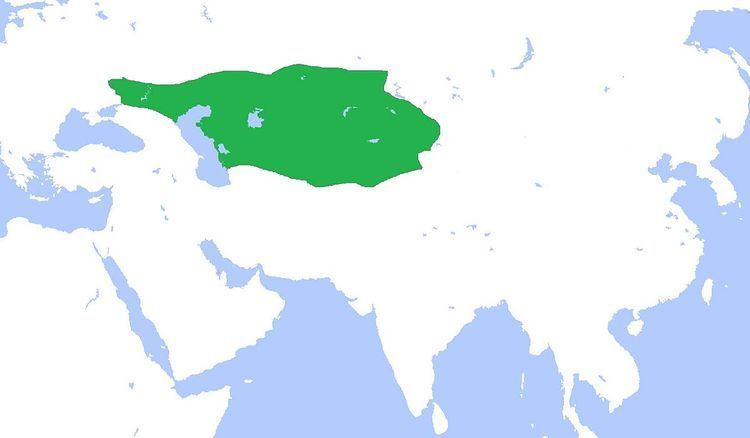Languages Turkic Political structure Khaganate | ||
 | ||
630 3,500,000 km² (1,351,358 sq mi) | ||
western turkic khaganate atlas released in kazakhstan
The Western Turkic Khaganate or Onoq Khaganate (Chinese: 西突厥; pinyin: Xi tūjué) was a Turkic khaganate formed as a result of the wars in the beginning of the 7th century (593 – 603 AD) after the split of the Göktürk Khaganate (founded in the 6th century in Mongolia by the Ashina clan) into the Western khaganate and the Eastern Turkic Khaganate.
Contents
At its height, the Western Turkic Khaganate included the later areas of Kazakhstan, Kyrgyzstan, Tajikistan, Turkmenistan and Uzbekistan.
The ruling elite of the Western Turkic Khaganate were the Onogurs – an oğuz (literally "arrow"), a subdivision of the Turkic tribes. The name of the Onugurs is derived from the proto-Turkic Onoq ("ten arrows").
Initially, the Western khaganate sought friendly relations with the Eastern Roman Empire, in order to expand their territory at the expense of their mutual enemy, the Sassanid Persian Empire.
The Western and Eastern khaganates were reunited as the Turkic Khaganate in 682.
History
For the origin of the Onoq two contradicting accounts are given:
In the beginning [after 552], Shidianmi [Istämi] followed the Shanyu [Qaghan] and commanded the ten great chiefs. Together with their 100,000 soldiers, he marched to the Western Regions and subdued the barbarian statelets. There he declared himself as qaghan, under the title of ten tribes, and ruled them [the western barbarians] for generations.
Soon [after 635], Dielishi Qaghan [of the Western Göktürks] divided his state into ten parts, and each was headed by one man, together they made up the ten she [shad]. Every she is given an arrow by him, thus they were known as the ten arrows. He also divided the ten arrows into two factions, each consisted of five arrows. The left [east] faction consisted of five Duoliu (Duolu) tribes, headed by five chuo [qur] separately. The right [west] faction consisted of five Nushibi (Ch. 弩失畢) tribes, headed by five sijin [irkin] separately. Each took command on one arrow and called themselves as the ten arrows. Thereafter, each arrow was also known as one tribe, and the great arrow head as the great chief. The five Duoliu tribes inhabited to east of Suiye [water] (Chu River), and the five Nushibi tribes to the west of it. Since then, they called themselves as the ten tribes.
The first statement dates their origin back to the beginning of the First Turkic Qaghanate with Istämi, younger brother of Tumen (Bumen), who had brought with him the ten tribes probably from the Eastern Qaghanate at Mongolia and left to the west to expand the Qaghanate. The exact date for the event was not recorded, and the shanyu here referred to might be Muhan Khan.
The second statement contributes it to Dielishi, who took over the throne in 635 and began to strengthen the state by further affirming the initial ten tribes and two tribal wings, in contrast with the rotation of rule between the Tumen (through Apa) and Istämi (through Tardu) lineages in the Western Qaghanate. Thereafter, the name "ten tribes" (十姓) became as a shortened address for the Western Turks in Chinese records. However it should be noted that those divisions did not include the five major tribes, who were active further east of the ten tribes.
The earlier tribes consisted of eight primary tribes ruled by ten chiefs-in-command, afterwards called the on (ten) oq (arrows) (十箭). They were the five Duolu (咄陆) tribes, and the three Nushibi (弩失毕) tribes. The relationships between the ten tribes and the ruling elites were divided into two groups. The more aristocratic Duolu tribes, who held the title qur, and the lower-rated Nushipi in west, who were probably initially made up of Tiele conscripts. During the reformation the more powerful Nushipi tribes such as A-Xijie and Geshu were sub-divided into two tribal groups with a greater and lesser title under a fixed tribal name.
In 619 the Western Turks invaded Bactria but were repulsed in the course of the Second Perso-Turkic War. During the Third Perso-Turkic War Khagan Tung Yabghu and his nephew Böri Shad joined their forces with Emperor Heraclius and successfully invaded Transcaucasia.
The khaganate's capitals were Navekat (the summer capital) and Suyab (the principal capital), both situated in the Chui River valley of Kyrgyzstan, to the east from Bishkek. The khaganate was overrun by Tang Chinese forces under Su Dingfang in 657-659 during the Tang campaign against the Western Turks.
